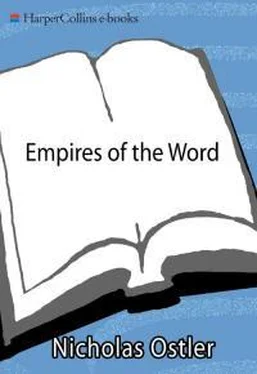Anderson (1991) is a good guide to the short but fraught history of the concept of the nation, and its transplantation for use all over the world.
Sahagün, vi. 13.
Karttunen (1990: 291-4).
Quotations from three Nahuatl speakers, cited in King (1994: 136-7).
Aulus Gellius, Noctes Atticae , xvii.17: Quintus Ennius tria corda habere sese dicebat, quod loqui Graece et Osce et Latine sciret.
e.g. in Lipiński (1997:46).
Firth (1964: 70-1). This is a reissue of works originally published in 1937 and 1930.
Whitfield (1999: 36).
Tablet II, II. 36-48; text from Lambert (1960: 40); trans. W. G. Lambert in Pritchard (1969: 596-600), slightly modified.
II. 70-8; text from Lambert (1960: 148); trans. W. G. Lambert in Pritchard (1969:601).
Lipiński (1997: 42-4).
The Words of Ahiqar, col. xiv, 208-23; text from Lindenberger (1983: 209), with vowels supplied by Peter T. Daniels; trans. from Pritchard (1969: 430).
The evidence is in the Elamite pronoun system, and some features of noun and verb morphology; Diakonoff (1985: 3); McAlpin (1981). But the attribution is still controversial.
Lancel (1997: 437).
Such colonies included Seleuceia on the Tigris, Seleuceia on the Eulaeus—none other than Susa, formerly the Elamite and Persian capital—and modern Aï Khanum in the Bactrian far east, i.e. modern Afghanistan (Wiesehöfer 2001: 111-12).
Pritchard (1969: 56): Inanna’s Descent to the Nether World (trans. S. N. Kramer).
Tsereteli (1959 [1912]).
Expounded in Schmandt-Besserat (1997).
Hallo (1974: 185-6); the Hymn to Inanna is translated in Pritchard (1969: 579-82).
Pritchard (1969: 496): Love Song to a King (trans. S. N. Kramer), slightly adapted.
Pritchard (1969: 652): Ua-aua, a Sumerian lullaby (trans. S. N. Kramer), slightly adapted; .
Thomsen (1984: 293-4), quoting from Proceedings of the American Philosophical Society , 107(4), pp. 1-12; (trans. S. N. Kramer), slightly adapted.
Pritchard (1969: 651): The Curse of Agade, vv. 279-81 (trans S. N. Kramer); .
McAlpin (1981:60).
Malbran-Labat (1996: 56).
Wiesehöfer (2001: 10).
Diakonoff (1985:24).
Hallo (1974: 184).
Kramer (1979: 39).
This is the analysis of Malbran-Labat (1996).
Roux (1992: 276).
Sawyer (1999: 14).
Oded (1979); Oded, quoted in Garelli (1982: 438); and Roux (1992: 308).
Pritchard (1969: 284): from a display inscription in Sargon II’s show capital of Khorsabad (Dŭr Sharrukîn).
Tadmor (1982: 451).
Parpola (1999) claims it was quite deliberate: ‘The Aramaization of Assyria was a calculated policy aimed at creating national unity and identity of a kind that could never have been achieved, had the Empire remained a loose conglomeration of a plethora of different nations and languages.’
Garelli (1982:442).
Kaufman (1997: 114-15).
Dietrich (1967: 87-90).
ibid.: 90, citing Dietrich (1979: item 10).
Kaufman (1974: 165-70). And Parpola (1999) notes a slip of the stylus in Ashurbanipal’s library copy of Gilgamesh (mid-seventh century), which could only have been made by an Aramaic speaker: the glyph for ‘lord’ ( mara in Aramaic) in place of that for ‘son’ ( mara in Akkadian).
Pritchard (1969: 317): Historical documents, 5. Antiochus Soter (trans. F. H. Weissbach).
ibid.: 136: Poems about Baal and Anath, f.C (trans. H. L. Ginsberg).
Genesis xxvii.28 and 39. See also Gordon (1971: 122).
Ezekiel xxvii.3-11, 25-6, 32.
Lancel (1997: 357); Cribb et al. (1999: 225, 227).
Augustine, Letters , xvii.2 (Letter to Maximus Madaurus).
Pliny, Naturalis Historia , xviii.22.
Hanno, Periplus (Codex Palatinus Graecus 398, fols 55r-56r).
Augustine, Sermones , clxvii.4.
Plautus, Poenulus , 930-1028.
ibid., 1002-12: the translations of the Punic follow Sznycer (1967: 141-3).
Livy, xxviii.46.16.
Kaufman (1997: 115).
Greenfield (1985: 708); Polotsky (1971).
Thucydides, iv.50.
Daniel i.4.
Lemaire and Lozachmeur (1996: passim).
Greenfield (1985: 701, n. 2).
Pritchard (1969: 428): The Words of Ahiqar (trans. H. L. Ginsberg).
ibid.: 491: Letters of the Jews in Elephantine (trans. H. L. Ginsberg).
Schlumberger et al. (1958).
Henning(1949).
There is one curse-tablet of the fourth century BC, recently discovered at the Macedonian capital, Pella, which suggests that it was a variant Greek dialect, of the north-western type (Voutyras 1994).
Brock (1989: 19).
Saeki (1937).
Their paradoxical use of English to protect the use of German is described in Johnson-Weiner (1999).
Described from a Welsh learner’s viewpoint by Pam Petro (Petro 1997: 259-319).
Hadith of disputed authenticity. Al-Tabrizi (1985: 6006).
Attempted in Miquel (1968) and Planhol (1968).
Qur’ān, xcvi.1-2. Tantalisingly, the last word here is also often translated as ‘blood clot’. The semantic root of ’alaqin seems to be the idea of clinging.
Braudel (1993: 72), quoting the Arab historian Baladhori.
Lewis (1995: 184-6).
Frye (1993:99).
ibid.: 123.
Читать дальше











